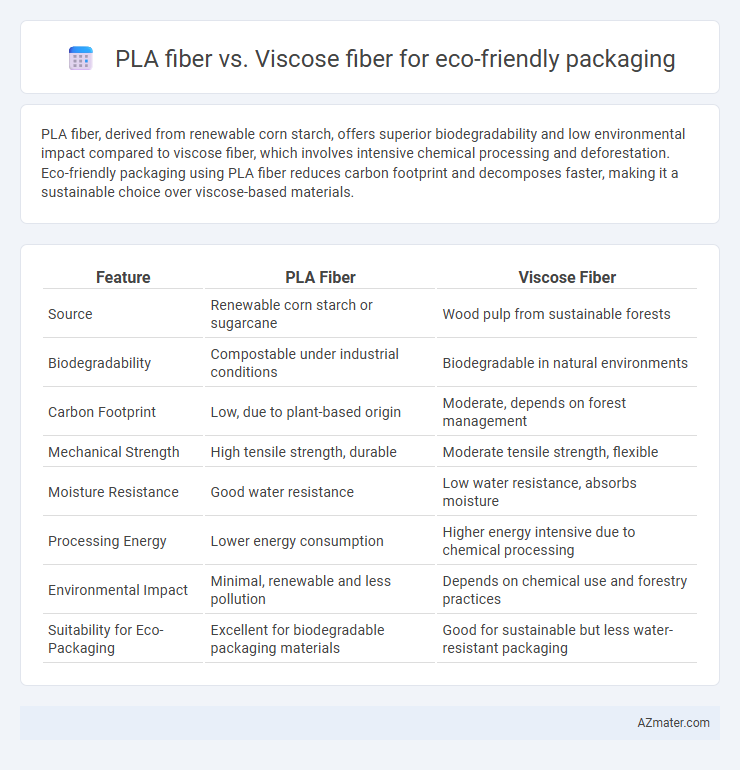PLA fiber, derived from renewable corn starch, offers superior biodegradability and low environmental impact compared to viscose fiber, which involves intensive chemical processing and deforestation. Eco-friendly packaging using PLA fiber reduces carbon footprint and decomposes faster, making it a sustainable choice over viscose-based materials.
Table of Comparison
| Feature | PLA Fiber | Viscose Fiber |
|---|---|---|
| Source | Renewable corn starch or sugarcane | Wood pulp from sustainable forests |
| Biodegradability | Compostable under industrial conditions | Biodegradable in natural environments |
| Carbon Footprint | Low, due to plant-based origin | Moderate, depends on forest management |
| Mechanical Strength | High tensile strength, durable | Moderate tensile strength, flexible |
| Moisture Resistance | Good water resistance | Low water resistance, absorbs moisture |
| Processing Energy | Lower energy consumption | Higher energy intensive due to chemical processing |
| Environmental Impact | Minimal, renewable and less pollution | Depends on chemical use and forestry practices |
| Suitability for Eco-Packaging | Excellent for biodegradable packaging materials | Good for sustainable but less water-resistant packaging |
Introduction to Eco-Friendly Packaging Materials
PLA fiber, derived from renewable resources like corn starch, offers a biodegradable and compostable alternative for eco-friendly packaging, significantly reducing reliance on petroleum-based plastics. Viscose fiber, sourced from cellulose in wood pulp, provides a biodegradable option with excellent breathability and softness but involves chemical-intensive processing that may impact its environmental credentials. Both materials contribute to sustainable packaging solutions, yet PLA's greenhouse gas reduction potential and compostability often make it preferable for eco-conscious brands seeking circular economy benefits.
Overview of PLA Fiber
PLA fiber, derived from renewable resources like corn starch, offers a biodegradable and compostable alternative to traditional synthetic fibers in eco-friendly packaging. Its ability to break down under industrial composting conditions reduces plastic pollution and supports circular economy initiatives. PLA fiber also exhibits good mechanical strength and moisture resistance, making it suitable for sustainable packaging applications.
Overview of Viscose Fiber
Viscose fiber, derived from renewable cellulose sources such as wood pulp, offers a biodegradable and compostable alternative for eco-friendly packaging solutions. Its high absorbency, smooth texture, and breathability make it suitable for preserving product freshness while reducing environmental impact. Despite requiring chemical processing, advancements in closed-loop production systems have significantly minimized its ecological footprint compared to conventional synthetic fibers.
Raw Material Sources: PLA vs Viscose
PLA fiber is derived from renewable resources such as corn starch, sugarcane, or tapioca roots, offering a sustainable and biodegradable alternative for eco-friendly packaging. Viscose fiber, on the other hand, originates from cellulose extracted from wood pulp, typically sourced from fast-growing trees but often involves chemical-intensive processes that can impact environmental sustainability. The renewable nature of PLA's agricultural raw materials contrasts with the forest-based cellulose of viscose, making PLA more favorable in reducing deforestation and promoting circular bioeconomy practices.
Production Process and Environmental Impact
PLA fiber, derived from renewable resources like corn starch, undergoes fermentation and polymerization, resulting in a biodegradable and compostable material ideal for eco-friendly packaging. Viscose fiber is produced by chemically treating cellulose from wood pulp with carbon disulfide and sodium hydroxide, a process that often involves toxic chemicals and generates significant environmental pollutants. The production of PLA fiber generally results in lower greenhouse gas emissions and less water pollution compared to viscose fiber, making PLA a more sustainable choice for environmentally conscious packaging solutions.
Biodegradability and Compostability Comparison
PLA fiber, derived from renewable corn starch, offers excellent biodegradability within industrial composting facilities, breaking down into water, carbon dioxide, and biomass in 90 to 180 days. Viscose fiber, produced from cellulose, is biodegradable under certain conditions but may take longer and requires specific environmental factors to fully decompose, sometimes resulting in microplastic residue. For eco-friendly packaging, PLA fiber demonstrates superior compostability due to its certified industrial compostable status, while viscose fiber's biodegradability is less predictable without controlled composting conditions.
Performance and Durability in Packaging
PLA fiber offers superior biodegradability and compostability compared to viscose fiber, making it highly suitable for eco-friendly packaging that requires rapid environmental breakdown. Viscose fiber provides excellent strength and softness, but it tends to degrade more slowly and may involve chemical-intensive production, affecting its overall sustainability. Performance-wise, PLA fibers maintain structural integrity under moisture exposure better than viscose, ensuring enhanced durability and protection for packaged goods.
Cost Analysis: PLA Fiber vs Viscose Fiber
PLA fiber generally incurs higher production costs than viscose fiber due to expensive raw materials like cornstarch and complex fermentation processes. Viscose fiber benefits from lower material costs, sourced primarily from wood pulp, but involves chemically intensive processing that can offset cost advantages through environmental compliance expenses. When assessing total cost, PLA's biodegradability and renewable sourcing often justify its premium in sustainable packaging applications, while viscose remains a cost-effective option with trade-offs in ecological impact and long-term disposal costs.
End-of-Life Options and Circularity
PLA fiber, derived from renewable resources like corn starch, offers compostability under industrial conditions, enabling effective end-of-life biodegradation that supports circular economy principles in eco-friendly packaging. Viscose fiber, produced from cellulose sources, is biodegradable in natural environments but often involves chemical-intensive processing, complicating its circularity and recycling potential. Choosing PLA fiber enhances packaging sustainability through clearer composting pathways and reduced environmental impact compared to viscose's ambiguous disposal and closed-loop recovery challenges.
Future Trends in Sustainable Packaging Fibers
PLA fiber, derived from renewable corn starch, offers superior biodegradability and compostability compared to viscose fiber, which is regenerated from wood pulp but relies on chemically intensive processing. Future trends in sustainable packaging prioritize the development of PLA fibers enhanced with natural additives to improve mechanical strength and thermal stability, meeting stricter environmental regulations. Innovations in viscose fiber production aim to reduce water and chemical usage through closed-loop systems, but the scalability and overall sustainability of PLA fibers position them as a leading choice for eco-friendly packaging solutions.

Infographic: PLA fiber vs Viscose fiber for Eco-friendly packaging
 azmater.com
azmater.com